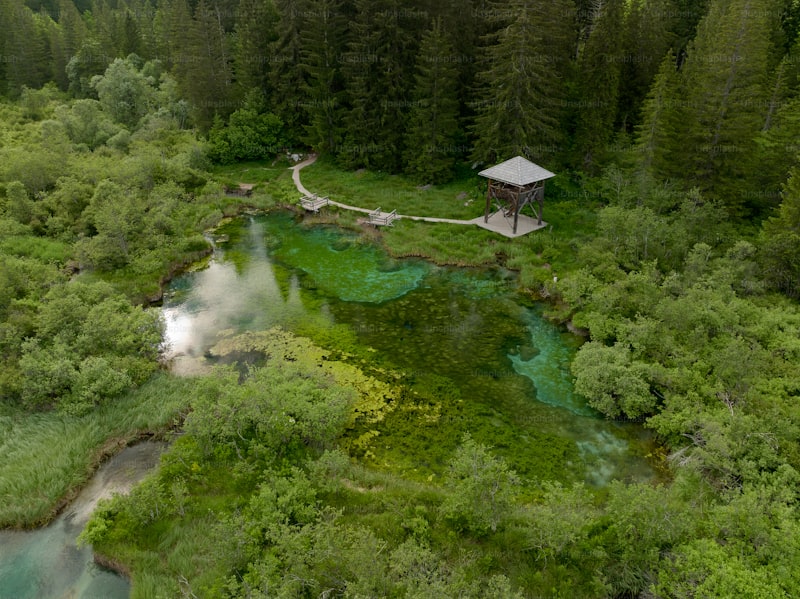Firstly, location is key. Choose a spot that receives a good balance of sunlight and shade throughout the day. This helps in establishing a healthy mix of aquatic plants and provides shelter for visiting wildlife. Remember, a variety of plants is crucial for oxygenation and filtration, so opt for native species that support local biodiversity.
Next, size matters. While smaller ponds can still attract wildlife, aim for a pond that is at least a meter deep in the center to accommodate different species. This depth provides a safe haven during hot summers and freezing winters, ensuring year-round usability for amphibians, insects, and even small mammals.
When it comes to construction, use a flexible pond liner to shape the pond’s contours naturally. This allows for a more organic appearance and reduces the risk of leaks. Incorporate shallow shelves around the pond’s edge, ideal for marginal plants like water mint or marsh marigold, which provide cover for amphibians and nesting areas for dragonflies.
To enhance biodiversity, include a variety of habitats within and around the pond. Add rocks or logs at the pond’s edge to create basking spots for reptiles and amphibians. Overhanging plants and grassy banks provide shelter for birds and small mammals. Introduce a diversity of materials and textures to mimic natural environments.
Maintenance is minimal but essential. Regularly remove fallen leaves and debris to prevent nutrient buildup, which can lead to algae blooms. A gentle annual clean in late winter helps maintain water quality without disturbing hibernating creatures.

Lastly, patience is key. A new pond may take time to establish itself as a thriving habitat. Be prepared to observe gradual changes as wildlife discovers and settles into their new home. By providing the right conditions and habitat diversity, your wildlife pond can become a haven for local flora and fauna, enhancing both your garden’s biodiversity and your enjoyment of nature’s wonders.
Transform Your Yard: Step-by-Step Guide to Creating a Wildlife Pond
Firstly, choose the right location for your pond. Opt for a spot that receives a good balance of sunlight and shade throughout the day. This ensures ideal conditions for both plants and aquatic life to thrive. Clear the area of any debris and level the ground to create a stable base.
Next, outline the shape of your pond using a garden hose or rope. Consider natural curves and varying depths to mimic a natural habitat. Dig the pond gradually, starting with shallow areas leading to deeper zones. This step is crucial for accommodating different aquatic plants and creatures.
Once the pond shape is dug, line it with a pond liner. Ensure the liner is securely positioned to prevent leakage. Rocks and gravel can be placed along the edges to anchor the liner and provide a natural look. Fill the pond with water, allowing the liner to settle into place.
Now comes the creative part—adding vegetation. Choose native aquatic plants like water lilies, cattails, and submerged oxygenators. These plants not only beautify the pond but also provide habitats for insects, frogs, and other wildlife. Introduce floating plants like water hyacinths for additional shade and oxygenation.
To attract more wildlife, consider adding rocks, logs, or shallow shelves around the pond’s edge. These features offer resting spots and shelter for visiting creatures. You might also incorporate a small pump or fountain to keep the water moving, which helps prevent stagnation and promotes a healthy ecosystem.
Maintaining your wildlife pond involves regular care and observation. Remove debris such as fallen leaves to prevent nutrient buildup. Monitor water levels and quality, especially during hot weather. With proper upkeep, your wildlife pond will continue to flourish, attracting a diverse array of birds, butterflies, and amphibians to your backyard sanctuary.
Eco-Friendly Gardening: Essential Tips for Constructing a Wildlife Pond
Creating a wildlife pond in your garden is not just about adding a water feature; it’s about fostering a miniature ecosystem right at your doorstep. Wildlife ponds are vital for supporting biodiversity, attracting beneficial insects, and providing a habitat for various creatures like frogs, dragonflies, and birds. Here are some essential tips to construct a wildlife pond that is eco-friendly and sustainable:
Firstly, choose a suitable location for your pond. Opt for a spot that receives a good amount of sunlight but also has some shade during the day to maintain water temperature and prevent excessive algae growth.
Next, think about the size and depth of your pond. Wildlife ponds don’t need to be very large; even a small pond can support a diverse range of wildlife. Ensure that there are shallow areas with gentle slopes to allow easy access for creatures like hedgehogs and birds.
Use natural materials such as rocks, logs, and native aquatic plants to construct the pond. These materials not only blend seamlessly with the surroundings but also provide hiding places and shelter for wildlife.
When filling the pond, use rainwater if possible to conserve resources and avoid introducing chemicals into the water. Rainwater is free from chlorine and other additives found in tap water, making it safer for wildlife.
To maintain water quality, consider adding oxygenating plants like water lilies and hornwort. These plants not only oxygenate the water but also provide food and shelter for aquatic insects and amphibians.
Regularly monitor and remove any invasive plant species that might take over the pond ecosystem. Balance is crucial in a wildlife pond to ensure all species thrive without one dominating the others.
Lastly, resist the temptation to introduce fish unless they are native species that won’t disrupt the delicate balance of the pond. Fish can prey on smaller creatures and disturb the habitat, potentially harming the ecosystem you’ve worked hard to establish.
Attract Birds and Butterflies: DIY Tips for Building Your Own Wildlife Pond
Before you start digging, carefully select the location for your wildlife pond. Opt for a spot that receives partial sunlight to encourage plant growth and provides easy access for visiting wildlife. Avoid areas directly under trees to minimize leaf litter and debris falling into the pond.
Sketch out a rough design for your pond, considering its shape and size. A natural pond shape with shallow edges works best for attracting wildlife, allowing easy access for birds to drink and butterflies to perch. Incorporate varying depths to accommodate different aquatic plants and provide shelter for small creatures.
Once you’ve marked out the area, it’s time to start digging. Aim for a depth of at least 18 inches in the center, gradually sloping towards the edges. Use the excavated soil to create gentle slopes and planting shelves around the pond. This not only enhances the natural look but also provides habitats for amphibians and insects.
To prevent water from seeping into the soil, line the pond with a durable pond liner. Ensure it overlaps the edges sufficiently to avoid leaks. Press the liner firmly into place, smoothing out any wrinkles to create a seamless finish.
Select a variety of native aquatic plants such as water lilies, cattails, and floating plants. These not only oxygenate the water but also provide food and shelter for wildlife. Incorporate rocks, logs, and shallow dishes filled with pebbles to create landing spots for butterflies and drinking stations for birds.
Regular maintenance is key to keeping your wildlife pond healthy and attractive. Remove debris such as fallen leaves and algae buildup regularly. Monitor water levels and top up as needed, especially during dry spells. Avoid using chemicals or pesticides near the pond to protect the delicate ecosystem.
Enhance Biodiversity: How to Design a Habitat-Friendly Wildlife Pond
Firstly, consider the location of your pond. Choose a spot that receives a good amount of sunlight for aquatic plants and is away from overhanging trees that can drop leaves and debris into the water. This helps maintain water quality and reduces maintenance.
When digging the pond, aim for a variety of depths to cater to different wildlife needs. Shallow areas are ideal for amphibians and smaller creatures, while deeper sections provide refuge for fish and aquatic plants. Incorporate gradual sloping edges to allow easy access for animals like hedgehogs or birds to drink and bathe.
Select native aquatic plants suited to your region. These plants not only beautify the pond but also provide essential habitats and food sources for wildlife. Consider plants like water lilies, rushes, and submerged oxygenators. They play a crucial role in oxygenating the water and filtering pollutants, creating a balanced ecosystem.
Introduce rocks, logs, or pebbles strategically around the pond’s edges. These features provide shelter for insects, amphibians, and small mammals. Logs partially submerged in water can serve as basking spots for turtles or resting places for dragonflies.
Maintain a natural balance by avoiding chemical treatments whenever possible. Wildlife ponds are self-regulating when properly designed, relying on natural processes to control algae and maintain water clarity. Regularly remove excess vegetation and debris to prevent nutrient buildup and keep the pond healthy.
By designing a wildlife pond, you invite nature into your backyard while contributing to conservation efforts. It’s a small, impactful way to support biodiversity and create a haven for local wildlife to thrive.
From Planning to Planting: Building a Wildlife Pond in Your Backyard
The first step in creating a wildlife pond is planning. Consider the location carefully; choose a spot that receives partial sunlight to encourage plant growth while providing shade for aquatic life. Measure the area to determine the pond’s size and shape. Will it be a small, cozy corner or a larger, more expansive feature?

Once you’ve marked out the pond’s perimeter, it’s time to dig. Excavation depth can vary, but a minimum of 18 inches is ideal for supporting diverse aquatic plants and wildlife. Create shallow areas for plants and deeper zones for fish and other creatures. Shape the pond with gentle slopes to allow easy access for wildlife.
Selecting native plants is crucial for supporting local wildlife. Species like water lilies, marsh marigolds, and irises provide food and shelter for frogs, dragonflies, and birds. Introduce submerged plants like hornwort and waterweed to oxygenate the water and create habitat for aquatic insects.
Enhance the natural look of your pond by strategically placing rocks, logs, and branches around the edges. These features offer resting spots for amphibians and basking areas for turtles. They also create sheltered nooks for smaller creatures seeking refuge.
Maintaining a wildlife pond involves regular upkeep. Remove excess vegetation to prevent overcrowding and maintain water clarity. Keep an eye on water levels during dry spells and top up as needed. Avoid using chemicals that could harm wildlife; instead, opt for natural solutions to control algae and promote a healthy ecosystem.
A wildlife pond isn’t just a feature; it’s a living, breathing part of your backyard. Sit back and observe as dragonflies dart over the water, frogs serenade at dusk, and birds visit for a refreshing drink. Your pond will evolve over time, attracting new species and becoming a sanctuary for local wildlife.
Creating a wildlife pond is a rewarding experience that connects you with nature in your own backyard. It’s a testament to the wonders of biodiversity and a reminder of the beauty that thrives when we invite nature into our lives.
Wildlife Haven: Creating a Sustainable Habitat with Your Pond
Firstly, consider the size and depth of your pond. A variety of depths, from shallow edges to deeper central areas, cater to different species’ needs. Shallow zones are perfect for attracting small amphibians and providing safe spots for birds to bathe, while deeper areas offer refuge during hot weather or cold snaps.
Choosing native aquatic plants is crucial for maintaining a healthy ecosystem. These plants oxygenate the water, offer shelter for aquatic creatures, and attract beneficial insects like dragonflies and bees. They also provide a natural filtration system, helping to keep the water clean and clear.
Introducing rocks, logs, and floating platforms around the pond enhances its appeal to wildlife. These features provide sunbathing spots for turtles, basking sites for amphibians, and resting places for dragonflies. Such structures mimic natural habitats, encouraging diverse species to visit and thrive.
Maintaining water quality is essential for the health of pond life. Regularly removing excess debris, such as fallen leaves and algae, prevents water stagnation and promotes oxygen levels. Consider using natural methods like barley straw or aquatic plants to control algae growth instead of chemicals, which can harm wildlife.
Lastly, avoid introducing non-native fish species that may disrupt the pond’s delicate balance. Native fish like minnows or mosquito fish can help control insect populations naturally, contributing to the pond’s ecological harmony.
By implementing these practices, you can create a sustainable pond habitat that attracts a wide range of wildlife, supporting biodiversity right in your own backyard.
Easy Steps to Building a Low-Maintenance Wildlife Pond
Firstly, choose a suitable location for your pond. Opt for an area that receives partial sunlight to support both aquatic plants and wildlife. Ensure the spot is away from overhanging trees to prevent debris from falling into the pond.
Next, outline the shape and size of your pond using a garden hose or rope. This step helps visualize the final layout and ensures it fits harmoniously within your garden landscape.
Dig the pond to your desired depth, keeping in mind the need for varying depths to accommodate different wildlife. Shallow areas are ideal for small mammals and birds to drink from, while deeper sections provide refuge for fish and amphibians.
Line the excavated area with a pond liner to prevent water seepage. Use sand or old carpet as an underlay to protect the liner from sharp objects that may puncture it over time.
Fill the pond with water and let it sit for a few days to allow chlorine and other chemicals to dissipate. Rainwater is best for filling your pond as it lacks the harmful chemicals found in tap water.
Add native aquatic plants around the pond edges and floating plants like water lilies to provide cover for wildlife and improve water quality naturally. These plants also attract beneficial insects like dragonflies, which help control mosquitoes.
Introduce wildlife-friendly features such as rocks, logs, and a shallow beach area to encourage animals like frogs and newts to visit and breed. These features also create habitats for insects and microorganisms that form the basis of a healthy pond ecosystem.
Monitor your pond regularly to maintain water levels and remove any debris that may accumulate. A simple net can be used to skim leaves and other organic matter from the surface.
Frequently Asked Questions
What are the essential steps to build a wildlife pond?
Discover the essential steps required to create a thriving wildlife pond with our concise guide. Learn how to select a suitable location, excavate the pond, install a liner, and choose native plants to attract diverse wildlife. Ensure your pond supports biodiversity and enhances your outdoor space effectively.
How do you choose the best location for a wildlife pond?
Discover how to select the ideal site for a wildlife pond. Learn about factors like sunlight exposure, proximity to trees, and natural water flow, ensuring a thriving ecosystem for local wildlife.
How do you maintain a healthy ecosystem in a wildlife pond?
Learn how to maintain a healthy ecosystem in your wildlife pond with these essential practices: balance plant and animal life, avoid chemical treatments, regularly clean debris, monitor water quality, and promote biodiversity.
What materials are needed to construct a wildlife pond?
Discover the essential materials required to construct a wildlife pond efficiently. Learn about the key components needed for creating a thriving habitat, ensuring a successful and sustainable pond ecosystem.
What plants are ideal for attracting wildlife to a pond?
Discover which plants are best suited for attracting wildlife to your pond with our concise guide. Learn about native aquatic plants that provide habitats and food sources for various animals, enhancing biodiversity and natural balance in your aquatic environment.


